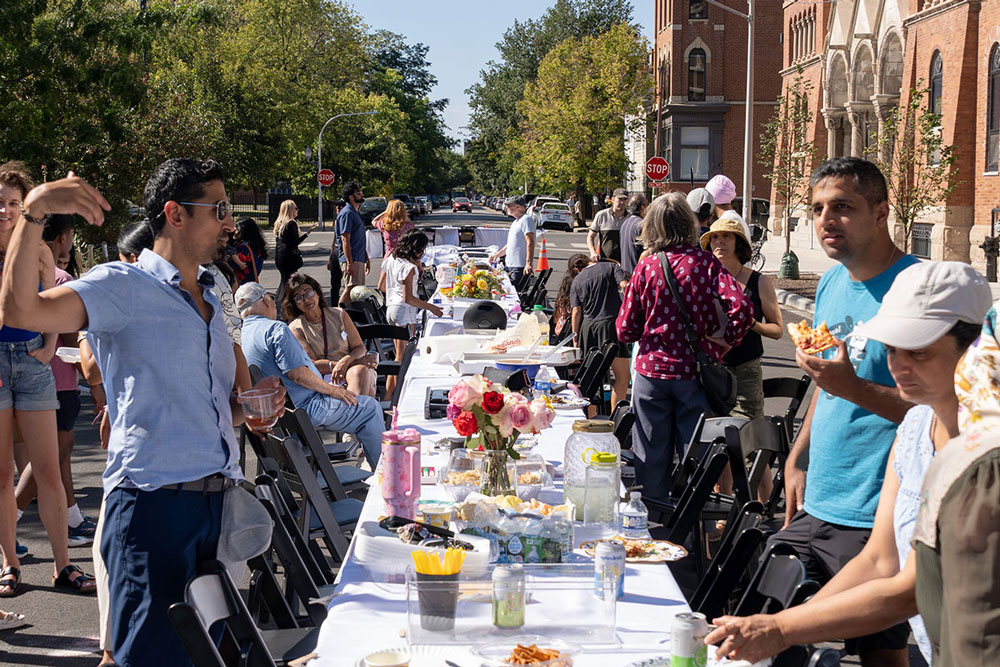
Editors’ note: This article, first published in print during July/Aug 2014, has been republished for Nonprofit Quarterly with minor updates.
Author’s Note: This article is the first in a series that will explore how different social justice movements in history were resourced. How past movements, and the organizations that led them, fundraised has not been well documented. Sometimes all we see is just a few sentences buried in the middle of a larger book about the movement’s political strategy or a flyer or memo stored away with other archived documents. This we have little regular access to the fundraising successes and mistakes of past activists, making it harder for us to learn from their work in order to strengthen our own. The goal of this series is to shed some light on these stories and hopefully inspire you to ask the movement veterans in your organization or community how fundraising was done back in their day. You might be surprised by what you learn.
FOR MANY PEOPLE, the words “Sí Se Puede” and the image of the angular black eagle on a red and white flag are synonymous with César Chávez, the United Farm Workers (UFW), and the popular social movement for farm worker dignity in the United States in the 1960s and 1970s. Th UFW holds an almost sacred place in movement history as an example of a true grassroots movement that changed not only the lives of many farm workers, but also how Americans thought about the people who grew their food.
Many movement fundraisers, myself included, have heard stories about how Chávez exhorted a young Dolores Huerta not to shy away from asking poor people to pay membership dues. But the story of how the UFW’s fundraising strategies helped build the organization might be different than you imagine. It is a practical yet inspiring story about asking for what was needed and of many hours of hard work by both paid staff and countless volunteers who raised money for and gave money to La Causa.
In 1966, the UFW Organizing Committee was born out of the merger of two unions: the AFL-CIO affiliated Agricultural Workers Organizing Committee (AWOC), whose members were mostly Filipino, and the Chávez founded National Farm Workers Association (NFWA), whose members were predominantly Mexican. The merger came out of a five-year strike in California’s
UFW LEADERS ALWAYS HAD A VISION OF BUILDING A BROAD SOCIAL MOVEMENT TO SUPPORT FARM WORKERS, NOT JUST A TRADE UNION, SO FUNDRAISING BECAME A KEY WAY TO ENGAGE NON-MEMBERS IN THE WORK AS WELL AS BUILD A MUCHNEEDED STRIKE FUND FOR WORKERS.
Central Valley and a subsequent national boycott against several growers including grape, lettuce and wine companies. The striking farm workers were often met with violent and racist opposition but, under the leadership of Chávez and others, adopted the practice of non-violence, which helped them win public broad support. During the boycott, millions of Americans stopped eating grapes, which put pressure on the companies to meet the workers’ demands. The result was that the union won unprecedented contracts for farm workers with better pay, benefits and protections. The movement also powerfully connected middle class Americans with the struggles of the workers who grew their food.
One Fundraising Decision Shapes the Union
It is not widely known that César Chávez did not imagine building the organization that eventually became the UFW through the traditional trade union route of organizing at the worksite, which was difficult to do given the migratory nature of farm work and the hostile conditions in the fields. Instead, his vision was to offer social services to help poor farm workers as a way to build relationships with and organize them for better working conditions. To that end, his NFWA had been awarded a $270,000 Office of Economic Opportunity (OEO) government grant to fund these services around the same time that the famed Delano grape strike had begun. When the powerful growers who were being targeted by the strike protested the grant, the OEO held it back for investigation. Chávez and the NFWA faced a big decision: take the money and put the strike and all that they had built at risk, or refuse the money and continue building the union in a different way, including raising money via membership dues. According to Thmas Karter, chief of the OEO Migrant Division who met with Chávez during this time, “[Chávez] decided that the strike and the concept of collective bargaining were more important than the $267,000 grant and calmly informed me that he would not accept the OEO grant until the strike was successful.”
The UFW Movement: “All We did was Constantly Ask People”
Like all unions, the UFW, once it was established, brought in most of its income from dues paid by its members. But that was after the UFW had won the contracts needed to ensure its members would have steady jobs with decent wages. Some of those contracts were won through the grape strike and boycott, but during the strike itself, UFW workers were dependent on the generosity of others to help them survive with no wages. Also, UFW leaders always had a vision of building a broad social movement to support farm workers, not just a trade union, so fundraising became a key way to engage non-members in the work as well as build a much-needed strike fund for workers. For UFW staff working during the boycott, asking for money and in-kind donations was an integral part of their organizing work.
“All we did was constantly ask people,” says Mary Jane Friel, who worked for the UFW from 1969 to 1978. The union paid each organizer a tiny salary of $5 a week (about $34 in today’s economy) and covered room and board. “[We fundraised] because we knew we had to survive, but that wasn’t the key. The key was that we had a vision for making life better for farm workers.”
Some of the ways that the UFW raised money included holding large benefit concerts (Joan Baez and Santana were just two of the big names that played at fundraisers), selling UFW buttons and bumper stickers, getting supporters to host house parties (one party, attended by César Chávez in Chicago, raised at least $10,000 during the grape boycott, equivalent to $67,000 today), and asking for honoraria or other donations when doing presentations at churches or community groups.
Veteran organizer Alfredo de Avila—who organized for the NFWA and then UFW from 1967 to 1973 in California as well as in Houston, Chicago and Buffalo—also spoke about how fundraising was part of his work with the union: “I had to raise $2,500 [about $17,000 today] to meet my budget… Anytime you made a presentation, at a school, church, etc., you would ask for an honorarium. You’d make a fundraising pitch at every event that you were speaking at.”
de Avila notes the importance of keeping in mind the differences in the economic conditions of the United States during the 1960s and 1970s and today: “Money went a lot farther back then,” says de Avila, remembering his time in the UFW in the 1960s. “Back then, $1 could buy three gallons of gas. So raising $1 back then is like $12 today.”
The art of thanking donors early and often was not lost on Chávez, a consummate relationship-builder. Friel, who was Chávez’ assistant from 1971 to 1973, spent a good deal of time on this important fundraising task. “My first job was to make sure that every letter and donation from [Chávez’] fist fast was thanked and documented. Back then it was all on paper…and the donations were arranged by state, county, etc. So thanking was big. [As] César’s assistant, my job was to know at each event who he was meeting, who had given $10, $25, $50 or more. He wanted to thank them, individually. I traveled with him and would tell him about each gift big or small.”
More established trade unions were also asked to support the movement, although sometimes rank-and-file workers were more willing to give than the union leadership, which de Avila once used to the UFW’s advantage. “When I was in Buffalo,” he recounts, “I asked the Steelworkers to make a donation, and they were hesitant. Then we asked if we could make an ask [from the workers] at the plant. We raised $357 in change and small bills, and then we told the union leadership. They got all embarrassed and ended up giving us $1,000.”
A few larger unions were a major source of financial support for the fledgling UFW, giving tens of thousands of dollars over several years. The United Auto Workers (UAW), for example, pledged $5,000 a month early on for the duration of the grape strike and also gave $50,000 (more than $300,000 in today’s dollars) for the construction of the UFW’s main office building in Delano.
Volunteers Make the Difference
While UFW leaders certainly asked for money, they also asked for time, and lots of it. None of the major accomplishments of the UFW—from the grape boycott to construction projects at its headquarters in Delano, CA—would have been possible without a veritable army of volunteers.
“[Volunteers] devoted a lot of their time and energy working for the UFW,” stated long-time AWOC and later UFW organizer Philip Vera Cruz in his memoir1. “The UFW…was able to get active volunteer support from outside the actual membership of the union… The boycott, for example, was based in cities around the United States and all over the world. And these were not farm workers alone who were responsible for the success but also students, church people, professionals, housewives and other labor unions in countries as far away in Europe as England, Sweden, France and Germany.”
Sign up for our free newsletters
Subscribe to NPQ's newsletters to have our top stories delivered directly to your inbox.
By signing up, you agree to our privacy policy and terms of use, and to receive messages from NPQ and our partners.
According to another long-time UFW staffer, Leroy Chatfield, the fist UFW office building in Delano, a farm worker health clinic, a gas co-op, and even Agbayani Village, a retirement compound for aging Filipino UFW members, were built entirely with volunteer labor led by Chávez’ brother Richard who was a master craftsman. 2
YOUR FUNDRAISING STRATEGY BOTH SHAPES AND IS SHAPED BY YOUR PROGRAMS, YOUR ORGANIZING, AND YOUR CORE VALUES.
Volunteers were a crucial part of the UFW’s organizing and fundraising efforts during the grape boycott as well. “[In towns] where we didn’t have a lot of staff we depended on our [volunteer] committees to raise money,” says de Avila. “Some committees were just five people in the neighborhood; they were taking on the main responsibility of taking on house meetings.” In larger cities, de Avila remembers having 30 to 40 volunteers on hand each day handing out tens of thousands of fliers to the public about the boycott, a feat that never could have been accomplished with just paid staff.
Friel also emphasized the importance of in-kind donations of food, shelter and other necessities for organizers and farm workers during the grape boycott. As important as cash donations, these contributions of goods and services provided crucial sustenance to UFW staff and farm worker members who traveled all over the country organizing pickets and other public support for the grape boycott. “I went on the boycott to New York [with] 87 farm workers,” says Friel. “We got places [to stay] in every borough donated. I got an office at Riverside drive, the Methodist church had a free office, and they had a farm worker committee. Thy provided us with phones, a copier, all that kind of stuff”
Another UFW organizer during that time, Mary Ann McGivern, recalled how Catholic religious communities and other unions were a resource for the movement. “[We would] ask various large houses of Catholic sisters that had their own Xerox copiers to run 1,000 pages [for boycott leaflets],” says McGivern. “We laid out the leaflets in half-pages, so that gave us 2,000 leaflets. Another route was to ask individual modest donors to cover the cost of a week’s printing. Sometimes a union or a union print shop would donate a leaflet run—maybe a month’s worth of leaflets.”
There was tremendous goodwill in the broader community for the UFW and la Causa, so organizers never went hungry—or thirsty. “People always knew that we [UFW organizers] had no money and were feeding us all the time,” says de Avila, who adds with a laugh, “I even had a bar where I paid 35 cents and I could drink beer all night.” Big Changes at the Union After the victories of the grape boycott, the UFW Organizing Committee was finally accepted into the AFL-CIO in 1972 and officially became the United Farm Workers. Unfortunately, in the years that followed—as often happens in popular social movements—internal strife plagued the union. For many, Chávez’ leadership became increasingly autocratic and problematic, leading to many key leaders resigning or being purged from the organization. Vera Cruz, who had been with the UFW since before the merger and was the main representative for the Filipino workers, was pushed to the margins of key decision-making and resigned in 1977. In addition to this hemorrhaging of leadership, the UFW board decided that same year to halt its organizing work and focus only on internal issues and the maintenance of current contracts. Eventually, this would ultimately weaken the union’s position.
“[From 1973 to 1977], Chávez’ drive to transform the UFW set the agenda. Only external events which could not be ignored, such as contract expirations or wildcat strikes, drew the union’s attention elsewhere,”3 writes Marshall Ganz in his book about the UFW.
On the financial end of things, the UFW moved to solidify its political power through large campaign contributions, including a controversial 1982 gift of $750,000 to California Assembly Speaker Willie Brown4. The organization turned to fundraising from individual donors who were not members of the union to maintain its budget. By 1981, membership dues only made up 27 percent of the union’s income, while 60 percent came from various fundraising strategies5, including direct mail. This stands in stark contrast to the UFW in 1971, when membership dues made up 60 percent of its income, or more than $1 million ($5.8 million in today’s dollars).
“Someone came and taught [the UFW] about direct mail,” says de Avila of this big shift in the UFW’s funding model. “That started raising almost $1 million a year. My aunt gave at least $50 a year for 30 years to the UFW that way. There were a lot of donors like that.”
While the organization was still being supported by a broad base of individuals, farm workers’ membership dues were no longer made up the majority of the UFW’s income. Fewer mechanisms existed that held the UFW accountable to either their farm worker members or to their donors. Marshall Ganz sums up the decline of the union: “[Th] living and working conditions of California farm workers are little better at the beginning of the 21st century than when [Chávez] began organizing in the early 1960s… The UFW no longer functions primarily as a farm workers union. Rather, it anchors a network of 14 nonprofit entities with combined assets of $42 million, collectively run by the Chávez family.”6
Lessons to be Learned
Despite this eventual shift away from its original mission and goals, the UFW and the farm worker movement it spearheaded offers valuable lessons for today’s fundraiser-activists:
Lesson 1: Ask, ask, ask! The first rule of fundraising is to ask for money. The UFW did this in spades, especially during the boycott, and involved everyone in the organization in fundraising efforts.
Lesson 2: Volunteers and in-kind donations are crucial parts of strong fundraising and strong movement building. Unpaid activists played a key role in building the boycott movement by walking picket lines, hosting house parties, organizing fundraising events, and providing food for striking farm workers. Without its huge base of volunteers, the UFW’s big victories would never have been won.
Lesson 3: Separating your core members/constituents and your donors can weaken your group’s accountability to both. Once the UFW had separated its main source of financial support from the base of people it claimed to represent, it lost much of its moral credibility and ability to win even bigger victories for farm workers.
Lesson 4: Fundraising matters. You can follow the changes in the way that the UFW fundraised and see a clear pattern of how its organizing and program work changed along with it. Organizing shaped fundraising and vice versa. Before the union won its contracts, external support from a broad base of people was crucial to help striking farm workers survive. After the boycott, union dues bolstered the UFW but were supplanted by individual donations when the group decided to move away from farm worker organizing.
If there is one overarching lesson to be learned from the example of the UFW, it’s that how your group raises money is deeply connected to everything else in your organization. Your fundraising strategy both shapes and is shaped by your programs, your organizing and your core values. Does your group’s fundraising align with your mission and deepest beliefs? We can learn much from both the achievements and mistakes of our forebears, like the UFW, about the powerful change that can take place when it is, and what can happen when it’s not. n
3 Marshall Ganz, Why David Sometimes Wins: Leadership, Organization,
and Strategy in the California Farm Worker Movement (New York: Oxford
University Press, 2010), 246
4 Ganz 248
5 Ganz 249
6 Ganz 239-240












